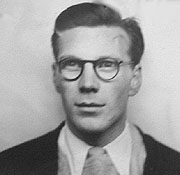Architect Harry Edwin Nordquist Jr. was born on December 13, 1910 in Seattle. After attending Broadway High School in Seattle, Nordquist received his formal architectural training at the University of Washington, where he received his Bachelor’s degree in architecture in 1933.
By 1936 Nordquist had established his own architectural firm in the Textile Tower in downtown Seattle. The next year he recieved his architectural license (No. TL 209). A talented designer, his business quickly developed and by 1937 his staff of two (Paul Sutherland and Vsvolad Prisadsky) was doubled with the addition of Basil Miles and Jerry Auld. That year the Seattle Times reported that Nordquist had over $90,000 in projects on the boards throughout the city. All the projects were residential and ranged in price from $3,500 to $16,000 dollars. His early designs ranged in style from Colonial to Tudor Revivals and included homes for Maurice Shapiro (1937); A.J. Nyberg (1937); John Malm House (1937); E.A. Warren (1938); M.M. Jensen (1939); and R.E. McGrew (1939).
Nordquist had a knack for working with developers and builders and throughout his career. As such, he created plans for a variety of housing tracks thoughout the city including designs for twelve model homes for builder Harry Edwin in the Madison Park neighborhood (1939). After the war he supplied over 200 designs for homes in the Mercerwood Housing development on Mercer Island in conjunction with architect Thomas A. Smith (1955). Among his last projects before retiring were several homes in the Lake Highlands subdivision (1964) overlooking Lake Washington.
Nordquist was an active member of the State Society of Architects, serving as their Secretary for a number of years. In the early 1960s he moved his office to Mercer Island but continued designing projects throughout the Puget Sound region. Notable projects include the Stanley Zielinski House (1958) in Bellevue; the Clyde MacDonald House (1964) in Kirkland; and the Tom Tabacco House (1970) in Seattle.
Nordquist was also an avid bowler and he used his passion to acquire several architectural commissions. Over the course of his career, he designed several bowling alleys including Greenlake Bowling (1949); The Ideal Lanes (1949) in downtown Seattle; Roxbury Lanes (1958); and Centennial Lanes (1976) in Kent.
He also designed several apartment complexes including the Parkside Apartments (1954); and a multiplex at 6011 California Ave. SW in West Seattle (1959). Other projects include the Ferncrest Sanitarium (1959) on Beacon Hill; and the Ferncrest Sanitarium (1963) in West Seattle.
By Michael Houser, State Architectural Historian, June 2012





